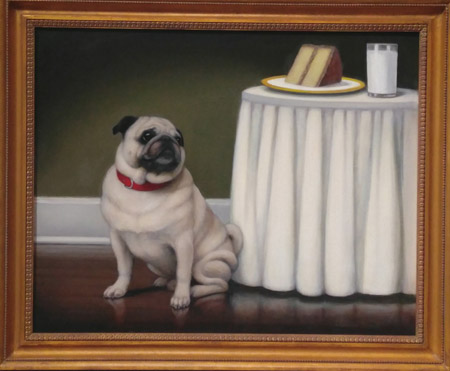
Pug
|
|
This dog is closely associated with the monarch, in this case William I of Orange (the Silent). The very early history of the Pug is a matter of conjecture. Although it is thought the breed originated in the Far East, it is not known how it first came to Europe, where it was recorded in Holland in the sixteenth century. Some historians say it may have been introduced to Holland by the Portuguese, soon after they opened sea trading routes with China around 1550. Another theory is it was brought to Holland by members of the Dutch East India Trading Company. Still other canine historians have written that Pugs came to Holland via "Muscovy," by which they probably meant Russia. However it came to Holland, the Pug became more or less the official dog of the House of Orange after one of the breed saved the life of William I of Orange in 1572 at the battle of Hermigny, when it gave alarm at the approach of the Spaniards. William III of Orange, great grandson of William the Silent, and his wife, Mary, also adored the breed, and numerous Pugs accompanied them when they crossed the English Channel in 1688 to ascend the throne of England. Indeed, it was the general custom to attach orange-colored ribbons to Pug's collars to denote their connection with the House of Orange. As a result of its popularity, the Pug found its way to other parts of the continent, vying with King Charles Spaniels and Maltese as court favorites and as prized pets of the wealthy and the elite. When the Pug first appeared in Holland, it was called the Dutch Mastiff or Dwarf Mastiff because its body contour and wrinkled head resembled the Mastiff. Indeed, Sydenham Edwards, writing at the beginning of the nineteenth century, noted that the small "Dutch Mastiff or Pug-dog was much in fashion." In the early part of the eighteenth century it was commonly called the Dutch Pug. Its name, wrote Stonehenge (the pseudonym of the nineteenth century canine writer John Henry Walsh), is derived from a Greek word that comes from the Latin pugnus, or fist, "because the shadow of a clenched fist was considered to resemble the dog's profile." The Pugs great popularity continued until the middle of the nineteenth century when other new small breeds appeared on the scene and the Pug gradually declined in both popularity and numbers. The breed fell on such hard times that many authorities of the day considered them to be nearly extinct. In 1872 a writer lamented that "it would be hard to find more than half a dozen specimens equal to what existed a hundred years ago." Gradually, however, Pugs began to regain their prestige. In 1885 attention was focused on the breed at the Pug Dog Show held at the Aquarium in London and the following report appeared in the Stock Keeper of June 19:"There is no mistake about Pugs being first favourites with the fair sex. The gallery was full of ladies" Several of the winning Pugs wore costly necklaces, and Lion, a first-prize winner, sported a necklace of turquoise. Black Pugs were first shown at the Maidstone show in 1886. Rawdon Lee tells us in his classic Modern Dogs that Queen Victoria owned a black Pug and that a photograph of the dog could be seen in one of the Royal albums devoted to dogs. |
Home | About
the WS Gallery | Current
Exhibition | New
Additions | Search Our Inventory
| Commissioning Paintings | 19th
& 20th Century Oils | Contemporary
Artists | Works
on Paper & Collectibles | Books
| Christine Merrill
| Guest book | Email
Us
All images, designs and information on this site
are fully copyrighted © 1999
and may not be reproduced of used in any form or any manner, or displayed in
any way
on any website without the express written consent of The William Secord Gallery,
Inc.
William Secord Gallery, Inc.
29 West 15th Street 4th floor
New York, NY 10011
Between Fifth and Six Avenues
www.dogpainting.com
wsecord@dogpainting.com
Tel. 212-249-0075
212-249-0896
By appointment
